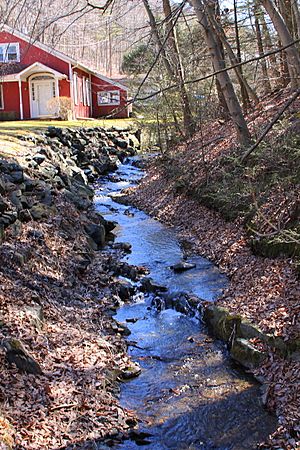Toby Run facts for kids
Quick facts for kids Toby Run |
|
|---|---|

Toby Run in its middle reaches
|
|
| Physical characteristics | |
| Main source | hills in Mahoning Township, Montour County, Pennsylvania |
| River mouth | Susquehanna River in Mahoning Township, Montour County, Pennsylvania 443 ft (135 m) 40°56′36″N 76°35′57″W / 40.9434°N 76.5991°W |
| Length | 1.7 mi (2.7 km) |
| Basin features | |
| Basin size | 0.9 sq mi (2.3 km2) |
Toby Run is a small stream in Montour County, Pennsylvania. It flows into the Susquehanna River. The stream is about 1.7 miles (2.7 km) long. It is completely located within Mahoning Township. The area of land that drains into Toby Run is about 0.9 square miles (2.3 km2). There are special valleys, called the Toby Run Ravines, near the stream. These ravines are important and are listed as a "Locally Significant" natural area. The Danville State Hospital is also found near Toby Run.
Contents
Where Toby Run Flows
Toby Run starts in the hills of southern Mahoning Township. It first flows southwest, then turns west or northwest for a short distance. After that, it makes a sharp turn back to the southwest.
The stream then flows past a reservoir (a place where water is stored) and a large hospital. It leaves the hills where it began. Soon after, Toby Run meets the Susquehanna River. This meeting point is near the southern edge of Mahoning Township. Toby Run joins the Susquehanna River about 138.56 miles (222.99 km) upstream from the Susquehanna's own mouth.
Land and Rocks Around Toby Run
Toby Run flows through a series of narrow valleys called ravines. These are known as the Toby Run Ravines. They are located in Mahoning Township and Cooper Township. The ravines are quite narrow. There is also a flat, high area of land, called a plateau, in the region where the stream collects its water.
The elevation of Toby Run near where it joins the Susquehanna River is about 443 feet (135 m) above sea level.
Toby Run's Water Basin
The area of land that drains water into Toby Run is called its watershed. This watershed covers about 0.9 square miles (2.3 km2). Toby Run is located close to the town of Danville.
History of the Toby Run Area
Long ago, there was a community called Toby Town near Toby Run. There was also a hospital for mental health nearby. The town was named after a "large and powerful" Native American person named Toby. We don't know for sure if this community was right by the stream's mouth or on a nearby ridge.
The land where the Danville State Hospital is built is within the Toby Run watershed. In the late 1800s, the hospital's gas works (where gas was made) were located at the mouth of the stream. In 1913, people thought about using Toby Run as a backup water source for the Danville State Hospital. A pumping station was also located near the stream to help move water.
Plants and Animals of Toby Run
Most of the trees in the Toby Run ravines are hemlock trees. However, the plant life in these ravines is very interesting and diverse. It includes many types of forests. Other trees like tulip poplar, beech, and sugar maple also grow here. The top layer of trees, called the canopy, is made up of hemlock and other northern hardwood trees.
Some plants that are not native to the area are slowly spreading in the ravine. These include Norway maple, multiflora rose, garlic mustard, autumn olive, and tree-of-heaven.
There are 14 different kinds of trees in the Toby Run ravine. There are also eight types of shrubs. These include alternate-leaved dogwood, red willow, multiflora rose, spicebush, American elderberry, wild hydrangea, autumn olive, and witch hazel. Plus, 22 types of herbs grow in the ravine. Some of these are dame's rocket, jewelweed, skunk cabbage, and Indian cucumber-root.
An insect called the hemlock woolly adelgid is a danger to the hemlock trees near Toby Run.
The Toby Run Ravines are considered a "Locally Significant" natural site. This means they are important for nature in Montour County. The entire watershed of Toby Run is also known as a "coldwater fishery." This means its waters are cold enough for fish that prefer cool temperatures.


